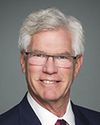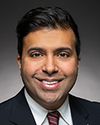Okay, we'll suspend the meeting. There will be a few minutes to change the panel, and then we will resume.
Everybody stretch for about three or four minutes.
Evidence of meeting #3 for Public Safety and National Security in the 44th Parliament, 1st Session. (The original version is on Parliament’s site, as are the minutes.) The winning word was guns.
A video is available from Parliament.
Noon
Liberal

The Chair Liberal Jim Carr
Okay, we'll suspend the meeting. There will be a few minutes to change the panel, and then we will resume.
Everybody stretch for about three or four minutes.
Noon
A voice
Thank you, Minister.
12:10 p.m.
Liberal

The Chair Liberal Jim Carr
I call the meeting back to order.
With us for the second hour, by video conference from the Canada Border Services Agency, we have John Ossowski, president; and Scott Harris, vice-president of the intelligence and enforcement branch.
From the Department of Public Safety and Emergency Preparedness, we have Mr. Rob Stewart, deputy minister; and Talal Dakalbab, assistant deputy minister, crime prevention branch.
From the Royal Canadian Mounted Police, we have Brenda Lucki, commissioner; Michael Duheme, deputy commissioner, federal policing; Stephen White, deputy commissioner, specialized policing services; Kellie Paquette, director general; and Mathieu Bertrand, director of federal policing criminal operations.
I will now open the floor to questions. This is a six-minute round, beginning with Mr. Van Popta.
The floor is yours, sir.
December 16th, 2021 / 12:15 p.m.
Conservative

Tako Van Popta Conservative Langley—Aldergrove, BC
Thank you, Mr. Chair, and thank you to all the witnesses for coming to this meeting.
We called this meeting to investigate gun control, illegal arms trafficking and gang-related violence in relation to recent shootings in Montreal, but sadly, Montreal is not unique in this. There is gun violence right across this country. It is also in metro Vancouver, where my riding of Langley—Aldergrove is.
Earlier this year, there was a whole rash of gangland-style shootings in metro Vancouver, including in Langley, where a person was shot and killed right in broad daylight in front of the Langley Sportsplex, where my grandkids play hockey. It was really quite shocking.
In the process, I started to look into gang violence more closely, and I was surprised to learn that we do not have nationwide systems for tracking the source of guns and firearms used in violent crime. We hear that most of the guns used in crime are smuggled in from the United States, but apparently those statistics are not necessarily reliable as there isn't a consistent requirement across the country that all police forces report that.
I wonder if any of the witnesses could comment on that, maybe starting with the RCMP.
12:15 p.m.
Commissioner Brenda Lucki Commissioner, Royal Canadian Mounted Police
Thank you, Mr. Chair.
What I can tell you is that, when we actually trace the firearms, we can know if they have been diverted, lost or stolen, and we can usually get to the source. In a year, we would trace approximately 2,500 firearms. When we do, of those 2,500, 58% of the firearms traced in Canada were domestically sourced. In the tracing centre, of the known source, 73% were deemed to be sourced within Canada and 27% were smuggled or possibly smuggled within the country from the U.S.
12:15 p.m.
Conservative

Tako Van Popta Conservative Langley—Aldergrove, BC
That's fair enough.
Is there consistency across the country in how these statistics are kept? I understand that Statistics Canada wants to start a study into this, but that, of course, is going to require consistent data keeping and sharing across all police forces. How consistent is it?
12:15 p.m.
Commr Brenda Lucki
When we do the proper tracing, the statistics are reliable, but it's only for the guns that we do trace.
I would ask Deputy Commissioner White to expand on that.
12:15 p.m.
Deputy Commissioner Stephen White Deputy Commissioner, Specialized Policing Services, Royal Canadian Mounted Police
Thank you very much, Commissioner.
Just to add to that, there is a requirement for police services across the country to report to the Canadian firearms centre all the firearms they seize. That is a requirement. In 2020, police services across the country seized over 30,000 firearms that were reported to the Canadian firearms program. One of the key pieces in terms of what we do with this data, as the commissioner just mentioned, is tracing. Unfortunately, right now we're just tracing a small number of the overall firearms that are reported to the tracing centre.
We are hoping to increase that, and the ultimate goal of what we are trying to do with that is to create a much better, more comprehensive intelligence picture. Tactical intelligence is going to be critical to effectively implement any strategy we're going to use against those who possess, use and traffic in illegal firearms.
We need a national, comprehensive picture. That's why we are in the process of developing a brand new, modern national criminal intelligence service system that will be used by all police services across the country for organized crime intelligence, gang intelligence, and included in there will be firearms intelligence.
12:15 p.m.
Conservative

Tako Van Popta Conservative Langley—Aldergrove, BC
Thank you for that.
I'm sure the statistics you keep are accurate; I didn't mean to suggest otherwise. I'm just concerned about how many guns that are used in crime are sourced. Do we understand where they come from, and how many of those were smuggled in?
We're parliamentarians who look to implement laws and regulations that are going to keep Canadians safe, but that's going to require us, first of all, to have good scientific data that we can rely on.
12:20 p.m.
Commr Brenda Lucki
I guess what I would reply to that question is that, with our Canadian Security Intelligence Service, we do a lot. Obviously, we all work together and we use a national database, as Deputy Commissioner White spoke about.
In that, we calculate the number of gangs. We calculate the crimes. We share the intelligence across organizations. I would say that the ones we do trace.... Obviously, we've expanded our capabilities. Until we can trace every firearm, we would not have a full picture, but we do have a good picture so far with the statistics, as Deputy Commissioner White shared and as I shared, with the domestically sourced versus those sourced outside of Canada.
12:20 p.m.
Conservative

Tako Van Popta Conservative Langley—Aldergrove, BC
We understand from Toronto Police Service that the vast majority of firearms used in crimes in that city were sourced from the United States. I suspect that Toronto Police Service probably does have the ability—
12:20 p.m.
Liberal

The Chair Liberal Jim Carr
Sorry, Mr. Van Popta, time is up. We'll have to wait for subsequent rounds.
Now I would like to call on Mr. Noormohamed.
You have six minutes, sir. The floor is yours.
12:20 p.m.
Liberal

Taleeb Noormohamed Liberal Vancouver Granville, BC
Thank you, Mr. Chair.
Thank you to all the witnesses for being here with us today.
Throughout the day, we've heard this sort of U.S.-style, NRA-style rhetoric that guns don't kill people and that the problem is not the guns but really the border.
I'm wondering, Commissioner Lucki and Mr. Ossowski, if you could share with us a couple of things. Number one, how should we be thinking about the whole question of why the average Canadian would need a handgun and/or a firearm in their home in metro Vancouver or in Montreal? Perhaps you could give us some of your thoughts on that.
Perhaps you could share a little bit more, Commissioner. You talked about domestically diverted arms. Perhaps you could take a minute to share with us your views on what's happening there. Perhaps, Mr. Ossowski, you could also weigh in on the issue of domestically diverted weapons so that we might have a better perspective on this.
12:20 p.m.
Commr Brenda Lucki
There are several reasons why people purchase firearms. Many are for sport, as well as for target shooting. They are not all directed at violence. There are a lot of responsible gun owners out there who take guns for such things as sport and target shooting competitions. That's why the firearms program is so very important. With our firearms program, we continue to work with Public Safety, CBSA and other policing partners to combat illegal firearms activity.
As I mentioned before, part of our goal is to enhance the capacity to trace firearms and to produce actionable intelligence that we need. We use that actionable intelligence so that we can look at the trafficking of firearms and target the firearms straw purchase activities as well. As organizations, we need to enhance that intelligence so that we can work with an organization like CBSA and other police of jurisdiction to target firearms smuggling into Canada.
I'll pass it over to John to add to that.
12:20 p.m.
John Ossowski President, Canada Border Services Agency
Thank you, Mr. Chair.
As the Commissioner alluded to, we're obviously responsible for the smuggling aspect at the port of entry. We look at it as a continuum: before the border, at the border, and after the border. Before the border, obviously, if we get intel about the arrival of something, we can stop that conveyance from crossing the border. At the border, obviously, is where we would see most of our seizures. I think you have data on that in terms of the seizure rate and the investments that have been made. We've had to up our game.
I think the real focus now for us is looking at the criminal networks and the trafficking routes and really trying to prevent those illicit firearms from crossing the border in the first place by disrupting these criminal routes. That's where the cross-border task force that we are leading, supported by the RCMP, is going to be critical in bringing together the insights of local police of jurisdiction as well as partners in the United States. In addition, we're working on an MOU to share information directly with the Bureau of Alcohol, Tobacco, Firearms and Explosives to really develop that intelligence picture.
Yes, we have investments in dogs and technologies that have proven to be extremely useful, but what we really want to do is swim upstream and disrupt those networks so they don't get across the border in the first place.
Thank you.
12:25 p.m.
Liberal

Taleeb Noormohamed Liberal Vancouver Granville, BC
Thank you very much.
I'm going to share the rest of my time with Mr. McKinnon, who I believe also has a number of questions he'd like to ask.
12:25 p.m.
Liberal

Ron McKinnon Liberal Coquitlam—Port Coquitlam, BC
Thank you, Mr. Noormohamed, and thank you all for being here today.
I know that gun violence, as Mr. Van Popta mentioned, is also a problem in British Columbia, the Lower Mainland in particular. A number of us on this committee are from British Columbia, and I'm interested in what could be done.
Commissioner Lucki, you said that 73% of firearms are sourced domestically within Canada. Of that 73%, are those illegal diversions? What percentage of that would be people who have stolen guns, purchased guns, and so forth? How many are legitimately owned by the people who are using them?
12:25 p.m.
Commr Brenda Lucki
Thanks for that question. I'm going to direct it to our director of the firearms program, who has many of those statistics.
Ms. Kellie Paquette, go ahead.
12:25 p.m.
Kellie Paquette Director General, Royal Canadian Mounted Police
The tracing of firearms actually happens in two major centres. There's one in Ontario, and there's one, the national centre, which is managed through the Canadian firearms program. In the national one, we had approximately 2,000 traces this year, and 73% were deemed to be imported legally, or manufactured in Canada. It's a very small percentage, but what we do is actually trace back to the multiple sources of that, or the owners of those firearms, so it's just not the last—
12:25 p.m.
Liberal

The Chair Liberal Jim Carr
Thank you. Time is up for that segment.
I would now like to invite Madame Michaud, for six minutes.
12:25 p.m.
Bloc

Kristina Michaud Bloc Avignon—La Mitis—Matane—Matapédia, QC
Thank you, Mr. Chair.
Good morning, Commissioner Lucki. It's a pleasure to have you back.
I think we're here to find solutions, of course, but, first of all, it's important to focus and understand the problem.
In your opinion, why are there so many guns coming into Canada across the U.S. border?
Do you feel that you have all the necessary and sufficient resources to intercept these weapons, both at the border, in co-operation with other agencies, particularly the Canada Border Services Agency, but also once they are in the hands of criminals?
12:25 p.m.
Commr Brenda Lucki
The RCMP's federal policing program uses all the tools and resources it has at its disposal to secure the border between the ports of entry and in line with its mandate. We're not designed to actually provide a patrol function along the border in its entirety. We have to deploy our limited resources in line with the threat environment. This flexible approach, though, actually allows us to face a wide range of current and emerging public safe priorities, including things like the smuggling of guns, illicit drugs, and organized crime.
We would welcome, obviously, investments in additional investigative capacity and especially technology, which would further strengthen our capabilities to counter these threats.
12:25 p.m.
Bloc

Kristina Michaud Bloc Avignon—La Mitis—Matane—Matapédia, QC
Thank you.
My next comments are for Mr. Ossowski.
I have in front of me an excerpt from an article in the newspaper 24 heures published on December 2 last year, in which Mark Webber, national president of the Customs and Immigration Union, proposes expanding the mandate of customs officers. In his view, this could be a solution to controlling firearms at the borders and it is a pity that officers cannot patrol with the RCMP between border crossings, as they have the expertise to do so. They could assist the RCMP, for example, with detector dogs, intelligence officers, and methods to combat concealed weapons. All these forms of expertise are available, but they could be better used.
I'd like to hear your thoughts on this.
Do you think it would be possible to broaden the customs officers' mandate? Should we ask the government to do so?